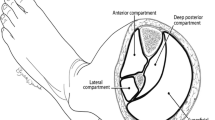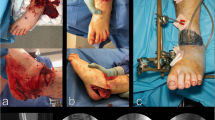Abstract
Purpose
The aim of this study was to evaluate a standardised algorithm to assess and treat impaired limb perfusion prior to surgical fixation of geriatric ankle fractures and determine the prevalence of peripheral arterial disease (PAD) in geriatric patients presenting with ankle fractures.
Methods
Eighty-four patients >65 years pre-operatively diagnosed and treated according to an algorithm (study group) were compared with 84 patients diagnosed and treated before the algorithm was introduced (control group).
Results
In 14 patients of the study group, clinical noninvasive examination revealed signs of relevant PAD, which was confirmed with computed tomographic angiography (CTA) in nine patients, all of whom had successful angioplasty prior to surgical fixation of the ankle fracture. In three of these patients, PAD had previously been diagnosed. After standardised diagnostics and treatment of malperfusion, a significantly reduced overall and, particularly, wound complication rate was found.
Conclusion
PAD is an underdiagnosed condition in geriatric patients presenting with ankle fractures. This study underlines the relevance of limb perfusion for adequate wound healing in geriatric ankle fractures. Therefore, special attention should be paid to diagnose and—if indicated—optimise limb perfusion prior to surgical fixation of geriatric ankle fractures.


Similar content being viewed by others
References
Kannus P, Palvanen M, Niemi S, Parkkari J, Järvinen M (2002) Increasing number and incidence of low-trauma ankle fractures in elderly people: Finnish statistics during 1970–2000 and projections for the future. Bone 31:430–433
Bariteau JT, Hsu RY, Mor V, Lee Y, DiGiovanni CW, Hayda R (2015) Operative versus nonoperative treatment of geriatric ankle fractures: a Medicare part a claims database analysis. Foot Ankle Int 36:648–655. https://doi.org/10.1177/1071100715573707
Sporer SM, Weinstein JN, Koval KJ (2006) The geographic incidence and treatment variation of common fractures of elderly patients. J Am Acad Orthop Surg 14:246–255
Aigner R, Salomia C, Lechler P, Pahl R, Frink M (2017) Relationship of prolonged operative time and comorbidities with complications after geriatric ankle fractures. Foot Ankle Int 38:41–48. https://doi.org/10.1177/1071100716667315
Zaghloul A, Haddad B, Barksfield R, Davis B (2014) Early complications of surgery in operative treatment of ankle fractures in those over 60: a review of 186 cases. Injury 45:780–783. https://doi.org/10.1016/j.injury.2013.11.008
Lynde MJ, Sautter T, Hamilton GA, Schuberth JM (2012) Complications after open reduction and internal fixation of ankle fractures in the elderly. Foot Ankle Surg 18:103–107. https://doi.org/10.1016/j.fas.2011.03.010
Basques BA, Miller CP, Golinvaux NS, Bohl DD, Grauer JN (2015) Morbidity and readmission after open reduction and internal fixation of ankle fractures are associated with preoperative patient characteristics. Clin Orthop Relat Res 473:1133–1139. https://doi.org/10.1007/s11999-014-4005-z
Belmont PJ, Davey S, Rensing N, Bader JO, Waterman BR, Orr JD (2015) Patient-based and surgical risk factors for 30-day postoperative complications and mortality after ankle fracture fixation. J Orthop Trauma 29:e476–e482. https://doi.org/10.1097/BOT.0000000000000328
Ovaska MT, Mäkinen TJ, Madanat R, Huotari K, Vahlberg T, Hirvensalo E, Lindahl J (2013) Risk factors for deep surgical site infection following operative treatment of ankle fractures. J Bone Joint Surg Am 95:348–353. https://doi.org/10.2106/JBJS.K.01672
BG. W (1972) Die Verletzungen des oberen Sprunggelenkes. Verlag Hans Huber, Berne
Charlson ME, Pompei P, Ales KL, MacKenzie CR (1987) A new method of classifying prognostic comorbidity in longitudinal studies: development and validation. J Chronic Dis 40:373–383
Anaestesiologists ASo (2015) American society of anesthesiologists. ASA physical status classification system. . In., http://www.asahq.org/resources/clinical-information/asa-physical-status-classification-system
Anderson SA, Li X, Franklin P, Wixted JJ (2008) Ankle fractures in the elderly: initial and long-term outcomes. Foot Ankle Int 29:1184–1188. https://doi.org/10.3113/FAI.2008.1184
Srinivasan CM, Moran CG (2001) Internal fixation of ankle fractures in the very elderly. Injury 32:559–563
norgren L, Hiatt WR, Dormandy JA, Nehler MR, Harris KA, Fowkes FG, Group TIW (2007) Inter-society consensus for the Management of Peripheral Arterial Disease (TASC II). J Vasc Surg 45(Suppl S):S5–67. https://doi.org/10.1016/j.jvs.2006.12.037
Lawall H, Huppert P, Espinola-Klein C, Rümenapf G (2016) The diagnosis and treatment of peripheral arterial vascular disease. Dtsch Arztebl Int 113:729–736. https://doi.org/10.3238/arztebl.2016.0729
Sorg H, Waizy H, Stukenborg-Colsman C, Vogt PM, Knobloch K (2012) Preoperative perfusion analysis before total ankle arthroplasty. Handchir Mikrochir Plast Chir 44:360–365. https://doi.org/10.1055/s-0032-1323656
Aust MC, Spies M, Guggenheim M, Gohritz A, Kall S, Rosenthal H, Pichlmaier M, Oehlert G, Vogt PM (2008) Lower limb revascularisation preceding surgical wound coverage - an interdisciplinary algorithm for chronic wound closure. J Plast Reconstr Aesthet Surg 61:925–933. https://doi.org/10.1016/j.bjps.2007.09.060
Funding
There is no funding source.
Author information
Authors and Affiliations
Corresponding author
Ethics declarations
Conflict of interest
The authors declare that they have no conflict of interest.
Informed consent/ethical approval
Designed as a retrospective study, a formal approval of the local ethical committee or an informed consent was not required.
Rights and permissions
About this article
Cite this article
Aigner, R., Lechler, P., Boese, C.K. et al. Standardised pre-operative diagnostics and treatment of peripheral arterial disease reduce wound complications in geriatric ankle fractures. International Orthopaedics (SICOT) 42, 395–400 (2018). https://doi.org/10.1007/s00264-017-3705-x
Received:
Accepted:
Published:
Issue Date:
DOI: https://doi.org/10.1007/s00264-017-3705-x




